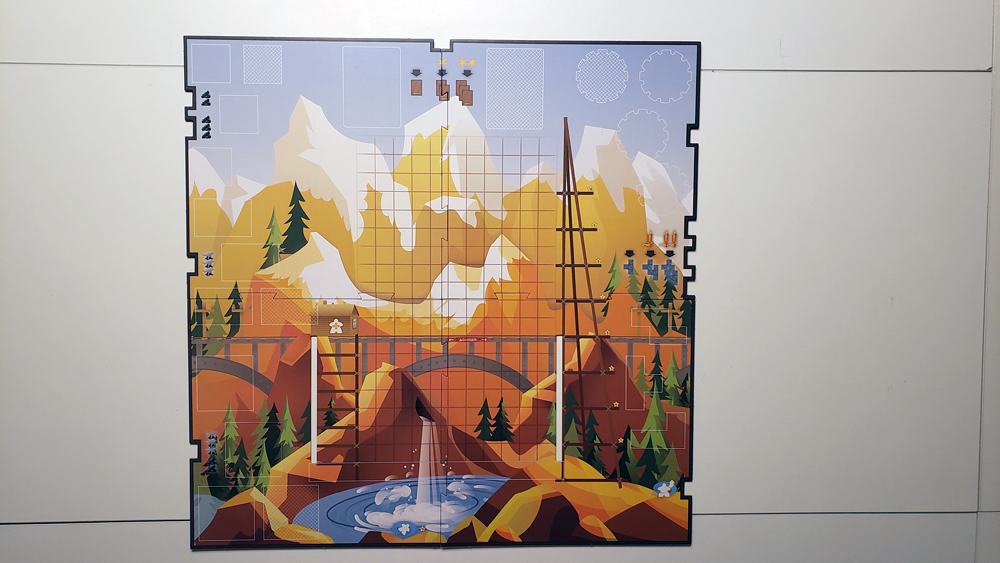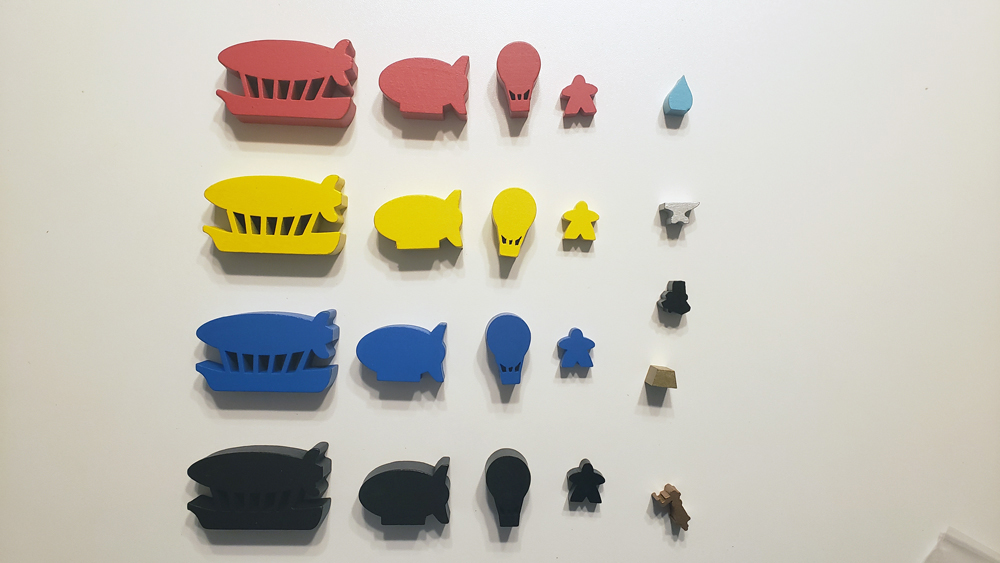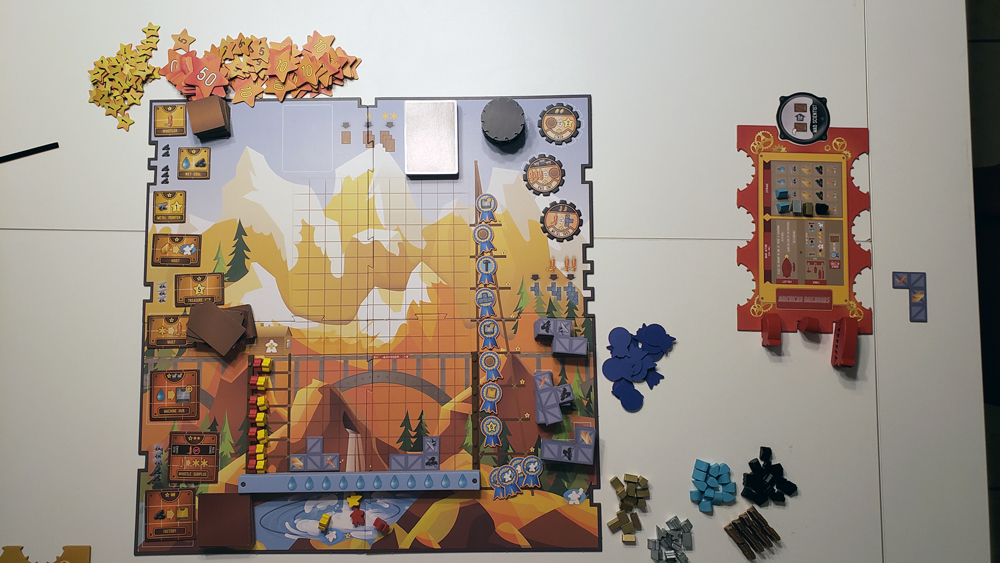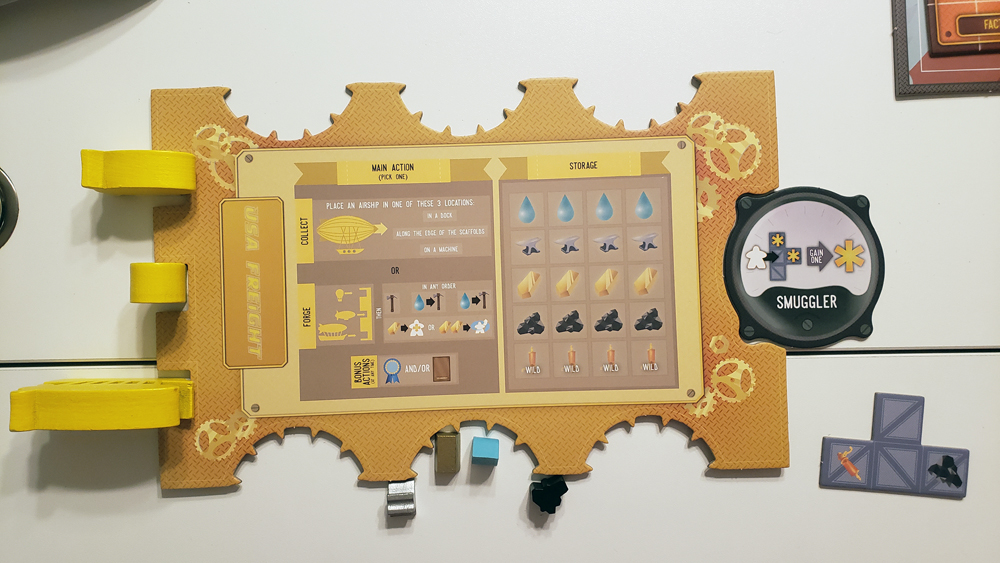I really like board games designed where there’s not just one particular way to win, especially when the play mechanic is fairly straight-forward and the strategy makes up the real challenge. Whistle Mountain from Bezier Games is exactly that sort of game. GeekDad Paul and I both received copies of this game to review from Bezier Games.
What is Whistle Mountain?
Whistle Mountain is a tile laying, worker placement, and resource managing game where viewers compete to earn Victory Points (VP) faster than their opponents through a variety of ways. The game is designed for 2-4 players ages 14+ and takes approximately 90 minutes to play. The game has a MSRP of $69.95.
Whistle Mountain Components

Whistle Mountain Contains the following:
- 1 Gameboard (4 pieces)
- 1 Instruction Booklet
- 1 Duplicator Token
- 4 Player Boards
- 24 Awards
- 8 Water Bars
- 2 Water Bar Holders
- 42 Scaffolds
- 17 Starting Abilities
- 24 Upgrades
- 16 Small Machines
- 20 Medium Machines
- 18 Large Machines
- 4 Hot Air Balloon Airships (in 4 Player Colors)
- 4 Blimp Airships (in 4 Player Colors)
- 4 Dreadnought Airships (in 4 Player Colors)
- 36 Workers (9 each in 4 Player Colors)
- 16 Coal Tokens
- 16 Iron Tokens
- 16 Water Tokens
- 16 Gold Tokens
- 16 Whistle Tokens
- 40 1 VP Stars
- 16 5 VP Stars
- 23 10 VP Stars
- 13 50 VP Stars
- 40 Cards
Overall, my first impression of the components is that they’re great and the amount and quality match up with what I would expect from a game in the $70 range. On your first play it will take you quite a bit of time to get some of these things punched out and sorted (plastic bags are included) so I think that stage took us about 30 minutes. Not an issue for us, but if you are setting this up as a game night sort of thing you should be prepared to calculate that into your playing time the first time around.

I really like the board and find that I’m starting to appreciate the puzzle piece board style more compared to the traditional fold up style. The art is simple but attractive and I really like how there’s a designated space for everything given the sheer amount of components the game contains. I find that level of organization really helps set-up too. There’s even little slots to put in the plastic Water Bar Holders. The board itself is cardboard but not as thick as the old style fold-up boards so it takes up less box space, yet it’s still sturdy.

The wooden components are brightly colored and easy to identify. I really appreciate the strength and quality of wood components and these don’t disappoint in the least. The Resource Tokens (Coal, Iron, Water, Gold, Whistles) are all easy to tell apart from each other during play. The Player Tokens (Workers, Hot Air Balloon Airships, Blimp Airships, and Dreadnought Airships) are easy to tell apart from each other as well as having distinctive enough colors to tell apart from other players.

The remaining cardboard-based pieces are sturdy and gorgeously designed. The Player boards have slots to pop pieces into, which really keeps your game space organized. Shapes and sizes are also used to help identify the pieces, making it way less overwhelming to keep track of what’s what. The remaining cards are pretty typical thickness and the designs are simple and easy to read.
I also want to note how well the instruction booklet was done. The fully colored diagrams made setup way less daunting and really helped to demonstrate the gameplay examples. There’s also a series of very nice tables explaining things like the Machines, Upgrades, Cards, Starting Abilities and Awards. Keep this in an easy to reach place while you play.
Summarized up, the components show not just quality but a lot of forethought in making the game easier to play.
How to Play Whistle Mountain
Goal
The goal of Whistle Mountain is to earn more Victory Points (VP) than the other players with a combination of resource management, worker placement, and tile laying. Some of your actions will build up your own efforts but a clever enough player can also sabotage the efforts of others.
Setup

With this many pieces, you are going to need some time for setup. Luckily the Instruction booklet has a beautifully labeled and organized diagram that helps you to set up the Game Board and the Player Boards. The fact that everything has a little designated area really helps to make this a smooth process.
Game Board Setup Steps:
Note, for your first game it is recommended to pull some of the more advanced pieces out including the Duplicator token, 3 Medium Machines (Dispatch, Elevator, Lift), 7 Large Machines (Coal Slide, Doomsday Device, Jetpack Lab, Sanctuary, Swap Meet, Toll Bridge, and Trap), 4 Starting Abilities (Aeronaut, Architect, Dreadnought, and Team Lead), and 4 Upgrades (Duplicator, Extension, Lifeboat, Shuttle).
- Assemble to Game Board and put it in the table center.
- Place 3 random Small Machines face up in the designated area and the rest in a face down stack.
- Place 3 random Medium Machines face up in the designated area and the rest in a face down stack.
- Place 3 random Large Machines face up in the designated area and the rest in a face down stack.
- Place the 2 Water Bar Holders in the slots and stack all 8 Water Bars below the first grid row.
- Create a pile of Resources
- Place 4 Rescue Awards on the lowest Tower Level
- Stack the Scaffolds in their designated spaces by shape.
- Place 1 random Award faceup on each remaining Tower Level. The rest go in a pile facedown.
- Place 3 random Upgrades faceup in the designated area and the rest in a facedown stack.
- Place the Duplicator token by the Game Board (Not used in first game play)
- Shuffle the Cards and place facedown in designated area.
- Create a pile of VP Stars.

Player Board Setup Steps:
- Choose a starting player.
- Take a Player Board and matching Airships by color.
- Each Player takes 1 Coal, 1 Iron, 1 Gold, and 1 Water. Player 2 gets 1 extra Water, Player 3 also gets 1 Whistle, Player 4 also gets 1 extra Water, and 1 Whistle.
- Place 1 Worker of each Player color on each level of the Barracks and place the other 2 in the Whirlpool.
- Starting with the last player, take a number of Starting abilities equal to the number of Players plus 1. That player keeps 1 Starting Ability and passes the rest to the right. The last Player to pick discards the one they don’t choose.
- Starting with the first player and moving left, each player picks 2 Scaffolds. One is placed by the Player’s Board in storage, the other is placed on the board with at least one edge aligned to the grid bottom.
Follow these steps in order and set up goes nice and quick considering the number of components involved. You are now ready to play Whistle Mountain.
Gameplay
Overall, the gameplay is something that you get more comfortable with as you play and get familiar with the game. At it’s very core though, a Player is essentially choosing between one of two choices each turn: Collect or Forge. Note: Players may take more than one action if they have a Card or Award that allow such.
Action: Collect
If a Player chooses Collect for their action, they must have an Airship still in their Dock. That Airship can be moved into a Machine on the grid, on the grid, or in a Dock. Airships cannot be placed on other Airships, Scaffolds not covered by Machines, or more than one Machine. Note, you are limited to 4 of each Resource and 6 Upgrades. Whistles are Wild Cards and may take the place of any other Resource.
Airship on the Grid:

Airships can only be placed where they have enough space. Draw an imaginary square or rectangle around this ship. Any machine touching this outer border can be activated. Any resource touching this border can be claimed.
Airship on a Machine:
Airships must be able to completely fit on a Machine. Draw an imaginary square or rectangle around this ship. Any machine touching this outer border can be activated including the one they are placed on. Any resource touching this border can be claimed.
Airship on a Dock

You can only Dock your Airship where you can afford to activate the action. Preform the action right away. If a Card lets you bump another Airship, that Airship goes back to its Player’s Dock. There are a number of Docks a Player may land on:
- Small Machine Dock 1: Spend 2 Coal to gain 1 Small Machine
- Small Machine Dock 2: Spend 3 Coal to gain 1 Small Machine
- Medium Machine Dock: Spend 3 Iron to gain 1 Medium Machine
- Large Machin Dock: Spend 3 Iron and 2 Coal to gain 1 Large Machine
- Card Dock: Gain 1 facedown Card for free or spend and 1 Resource and gain 2 facedown cards, or spend any 2 Resources for 3 facedown Cards.
- Upgrade Dock: Spend the cost printed on a faceup Upgrade and immediately activate it, placing it in a slot of your Player Board. Replace purchased Upgrade with a new Upgrade from the face down stack.
- Scaffold Docks: Gain 1 Scaffold for free from the top of any stack, or spend 1 Whistle and gain 2 Scaffolds from the top of any combination of stacks, or spend 2 Whistles and gain 3 Scaffolds from the top of any combination of stacks. Once a Scaffold is selected, the one under it is immediately available.
- Rescue Dock: Rescue 1 of your Workers from the Whirlpool and move it to an empty Scaffold space above the water.
Action: Forging
Return all of you Airships to your Player Board. If they’re already all there from a previous turn, that’s okay. You can Forge up to 4 Works in any order. Three Works can be Builds, 1 Work may be a Move or a Rescue. Your first build is free, a second or third in the same turn costs 1 Water each.
Building a Scaffold

Take a Scaffold from your Storage and place it on the board above the highest Water Bar. At least 1 square space must be adjacent to a visible Machine or Scaffold already on the grid. You may rotate or flip the Scaffold. Once place, score and collect 1 VP for every segment edge of the Scaffold that touches a visible Scaffold or Machine.
Building a Machine

Placing a machine takes a few more steps than a Scaffold.
- Pick a space to place your machine (horizontally or vertically) on a space on the Board that is completely covered by solid Scaffold spaces. There can be no holes, Water Bars, or other Machines. You can cover up resources.
- Any Workers that would be covered by the newly placed Machine are removed and promoted. Start with the Active Player and move each promoted Worker straight along the grid to the Tower to the right. If an Award is waiting in that Tower section, the Player of the first Worker to be promoted to the area takes it. Leave the Workers on the Tower as they will be worth VP at the end of the game.
- Place the Machine, claim the VP for building the Machine and gain the benefits from the Machine.
- Flood the canyon if needed. If any part of this new Machine is Build above the Bridge, floods hit. Add 1 Water Bar from the stack below the grid above the highest Water Bar for each machine Built above the Bridge. The following happens to any Game Components that the Water Bar(s) now touch(es): Any Airship that is even partially recovered returns to a Dock on its Player’s Board, Workers in the Barracks or on a Scaffold are swept into the Whirlpool, Any Machine that is even partially covered no longer works and cannot give benefits, and Scaffold spaces continue to work normally.
Moving or Rescuing a Worker

Moves let you put a Worker from the Barracks to Work, a Rescue pulls a Worker from the Whirlpool. Moving costs 1 Gold and you may Move a Worker from the Barracks to a Scaffold Space or a Worker from one Scaffold Space to another. Rescuing costs 2 Gold and you may move a Worker from the Whirlpool to the Scaffold.
Bonus Actions

You may play up to one Card and redeem one Award as Bonus Actions. Once played, the Card goes faceup in the Discard Pile, but the used Award is removed from the game. Bonus Actions can be taken at any point during a Player’s turn.
Turn End
Collect any Turn End benefits and pass play to the next Player.
Game End and Scoring

When there are no more Workers in the Barracks, Game End is triggered. The Active player finishes their turn and the other Players each get one last turn before Scoring. Players add the following VP points to what they have already earned:
- Tower: Score VPs indicated for each Worker on each Tower floor.
- Whirlpool: Loose 5 VPs for each Worker in the Whirlpool.
- Upgrades: Score the VPs indicated on each Upgrade.
- Storage: Score 1 VP for each Machine, 1 VP for each Award, 1 VP for every 2 Scaffolds, 1 VP for every 2 Cards, and 1 VP for any combination of 4 Resources.

The Player with the most VPs wins. In the case of a tie, the Player the Highest Worker in the Tower wins. If there is still a tie, the tied Player with the most Storage items wins. If a winner still can’t be determined, another game of Whistle Mountain will have to be played.
Why You Should Play Whistle Mountain
Simply put, Whistle Mountain is a very well put together game. GeekDad Paul clearly agrees with that sentiment as his review gave Whistle Mountain the coveted GeekDad Approved honor.
The game is gorgeous and has beautifully crafted components that are easy to identify and differentiate from each other. The Game Board and Player Board were designed to keep game play organized and smooth running, which is essential with a game that has as many components in play as Whistle Mountain. I really feel like it was designed to rein in any feeling of “this is going to be so complicated that I’m overwhelmed.”
The instruction booklet with it’s full color examples was a huge part of being able to quickly grasp how to play the game and made it very easy for us to go “okay, got it,” and get to playing. The setup diagrams really simplified everything so that we could get to playing faster. The reference guides in the back were also a nice touch instead of trying to cram everything onto a small Game Component.
Gameplay can feel like a lot, but it really comes down to making one of two choices and following the procedure there. It did not take long for us to catch on to the turn mechanic at all. That being said, there is a lot of strategy packed into this game. Deciding when to grab Resources, when to Build, and when to Rescue or move Workers is a careful balancing act. I cannot count the number of times I thought I had a nice combination set up only to have my husband thwart me with his next move. He also had a habit of building Machines in ways that didn’t promote my Workers which is super dangerous once those Water Bars start going up (once they start going up, they go fast). I lost a lot of points to Workers in the Whirlpool and the lost opportunity for those Tower points at the end really dinged my overall score. Players also really need to keep those End Turn abilities in mind. I had a nice amount of Upgrades going on that was supplying me with quite a few benefits on my turns to the point my husband had to find ways to cut off some of those benefits. I will note that the game also took us closer to 2 hours and 30 minutes to play. I’m not sure if it was because it was our first time playing, if games played with fewer players take longer, or because we Tetris placed a lot of those early Scaffolds so nicely that it took awhile before we started raising the Water Bar and loosing Workers from our Barracks.
The game is aimed at 14+, and between the playtime and the balancing act of all of the game aspects, I probably would not recommend trying it with an elementary age school kid that wasn’t already accustomed to playing longer games in the 14+ range. That being said, I’m pretty sure there are middle schoolers that should be able to handle this sort of game, especially if they’re already into strategy-based games. It might not be the best game to pull a casual or newer board gamer into, but I do think this would be a fun game to ease someone into over time.
Overall, it’s a great game for an evening board game night and it was so well done that I will eagerly be watching for other titles from Bezier Games. The game has a MSRP of $69.95 which lines right up with the quality and number of components, well done gameplay mechanics, and replayability. You can get a copy directly from Bezier Games here or via Amazon for $69.77.



